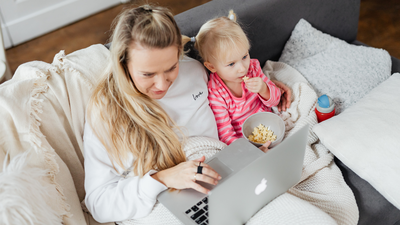
For millions of working parents in the United States, the promise of “balance” between career and family remains a distant ideal. Despite decades of workplace reforms and heightened awareness of gender equality, structural and cultural barriers persist, forcing many parents, especially mothers, into a constant juggling act. The 2025 FlexJobs Working Parents Report exposes a picture where unequal expectations, hidden labor, and inadequate policies intersect, shaping both career trajectories and family decisions.The pressures are both professional and personal. Beyond promotions and pay gaps, working parents navigate a maze of caregiving duties, financial burdens, and rigid work structures that disproportionately affect women. From concealing family responsibilities to managing guilt over time allocation, the survey illustrates that work-life balance is less a benefit than a continuous negotiation, with high stakes for parents, employers, and the broader workforce.
Mothers under the microscope: Higher standards at work
The survey, conducted between June 10 and June 24, 2025, with more than 2,200 professionals across industries, uncovers a consistent theme: Mothers are held to higher workplace standards than fathers. Half of all respondents (50%) perceive that working mothers face more rigorous scrutiny, while only one-third believe parents are judged equally. Fathers are rarely considered the primary targets of such expectations, accounting for 17% of perceptions.
Gendered perceptions: Divergent realities of parenthood
The survey reveals a striking divergence in perception between men and women. Women are over twice as likely as men to perceive that mothers face higher expectations (59% vs. 27%). Conversely, men more frequently report equality in treatment (48% vs. 28%) or bias against fathers (25% vs. 13%).This gap highlights the influence of gendered experiences at work. While fathers may feel insulated from scrutiny, women confront both subtle and overt pressures to perform flawlessly at work while maintaining primary responsibility at home. The consequences are significant, influencing career trajectories and reinforcing long-standing inequities in workplace dynamics.
The unequal load: Home and work responsibilities
The imbalance extends beyond perception to the actual distribution of labour. According to the FlexJobs survey, 52% of women report shouldering the majority of responsibilities at home and work, compared to only 31% of men. Even in arrangements described as “fairly balanced,” women are less represented, while men are more likely to claim parity in responsibilities.These findings reinforce the dual burden many women face, a combination of professional expectations and domestic duties that heightens stress and impacts career advancement.
Structural pressures: Childcare and work-life boundaries
Beyond gendered expectations, all working parents face structural barriers. High childcare costs (56%), difficulty maintaining clear work-life boundaries (50%), and limited availability of reliable childcare options (30%) emerged as top concerns.The emotional toll is substantial. Nearly three-quarters of parents report guilt or conflict about dividing time and energy between work and family. Moreover, 60% admit to concealing family responsibilities at work to appear more committed, 63% of women versus 51% of men, highlighting the ongoing stigma surrounding caregiving in professional settings.
Remote work , flexibility, and family planning
Flexibility emerges as a critical determinant of balance. Remote or hybrid work options are not mere conveniences but essential mechanisms enabling parents to maintain careers while raising families. The survey finds that 86% of workers view remote work as pivotal in family planning decisions, with 55% of women and 45% of men calling it “extremely important.”Return-to-office mandates have tangible consequences: Over one-third of parents say their current jobs do not support plans to start or expand families, while 10–11% report reconsidering or delaying children due to inflexible work arrangements.
Workplace solutions: Policies that make a difference
The report highlights that tangible policies, rather than symbolic gestures, are vital to supporting working parents. Key measures identified include:
- Flexible working hours (72%)
- Remote or hybrid work options (65%)
- Paid parental leave of 12+ weeks (47%)
- Generous family care sick leave (45%)
- Childcare assistance (37%)
These policies not only alleviate immediate pressures but also improve retention, career advancement, and employee morale. Nearly half of respondents say childcare benefits would increase their likelihood of staying in a role, while paid parental leave significantly enhances career support for women and men alike.
The broader implications: Gender equality and organisational success
The findings from the FlexJobs Working Parents Report illustrate that work-life balance is inseparable from workplace equity. Supporting working parents with flexible schedules, meaningful leave policies, and childcare assistance does more than improve individual outcomes; it fosters stronger teams, drives innovation, and enhances organisational performance.For employers, the message is clear: Sustaining a modern, productive workforce requires policies that recognise and accommodate the realities of parenthood. Without this support, talented professionals, particularly women, face untenable trade-offs, risking both career advancement and family well-being.








